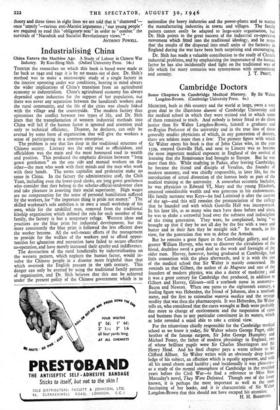Cambridge Doctors
MEDICINE, both in this country and the world at large owes a very great deal to the illustrious alumni of Cambridge University and
the medical school in which they were trained and in which some of them remained to teach. And nobody is better fitted to do them justice than Sir Walter Langdon-Brown, himself a graduate and
ex-Regius Professor of the university and in the true line of those generally erudite physicians of which, in any generation of doctors, there are seldom more than a few. The pioneer figure with which Sir Walter opens his book is that of John Caius who, in the year 1529, entered Gonville Hall, and next to Linacre was to become the most important medical exponent in England of the revival of learning that the Renaissance had brought to Europe. But he was more than this. While studying in Padua, after leaving Cambridge, he became the friend and disciple of Vesalius, the founder of modern anatomy, and was chiefly responsible, in later life, for the introduction of actual dissection of the human body as part of the medical training at the university. A somewhat eccentric bachelor, he was physician to Edward VI, Mary and the young Elizabeth, amassed considerable wealth and was generous in his endowments. His family surname was Keys—he had Latinised it after the custom of the age—and this still remains the pronunciation of the college that he founded and with which Gonville Hall was incorporat,id. In his later life, as so many wise men have done before and since, he was to shake a sorrowful head over the softness and indiscipline of the rising generation. They were, he complained, being "so brought up that if they be not all day by the fire with a toast and butter and in their furs they be straight sick." So much, in his view, for the generation that was to defeat the Armada.
But he remains a great figure in the Cambridge gallery, and the greater William Harvey, who was to discover the circulation of the blood, doubtless owed a good deal to the work and foresight of the older man. Harvey, however, having graduated at Cambridge, had little connection with the place afterwards, and it is with the rise of the medical school that Sir Walter is mainly concerned. He reminds us that Gilbert, the author of de Magnete and one of the founders of modern physics, was also a doctor of medicine ; and it was a great century for Cambridge that produced, in addition to Gilbert and Harvey, Glisson—still a textbook name in anatomy— Bacon and Newton. When one turns to the eighteenth century, a leading figure was Heberden, the friend of Johnson, also a textbook name, and the first to rationalise materia medial and the strange medley that was then the pharmacopeia. It was Heberden, Sir Walter tells us, who considered that the cures wrought at Bath were probably due more to change of environment and the suspension of cares and business than to any particular constituent in its waters, which at least revealed a mind able to take a critical view.
For the triumvirate chiefly responsible for the Cambridge medical school as we know it today, Sir Walter selects George Paget, elder brother of the famous surgeon, Sir John George Humphry and Michael Foster, the father of modern physiology in England, two of whose brilliant pupils were Sir Charles Sherrington and Sir Henry Head. And his final chapter pays a warm tribute to Ss Clifford Allbutt. Sir Walter writes with an obviously deep know- ledge of his subject, an affection which is equally apparent, and with all his usual charm and lucidity ; and incidentally it was pleasant as a study of the mental atmosphere of Cambridge in the troubled years before the Civil War—to find a reference to Miss Rose Macaulay's novel, They Were Defeated. Though one of the lesser known, it is perhaps the most important as well as the most fascinating of her books, and it is characteristic of Sir Walter Langdon-Brown that this should not have escaped his attention. ' H. H. BASHFORD.


























 Previous page
Previous page